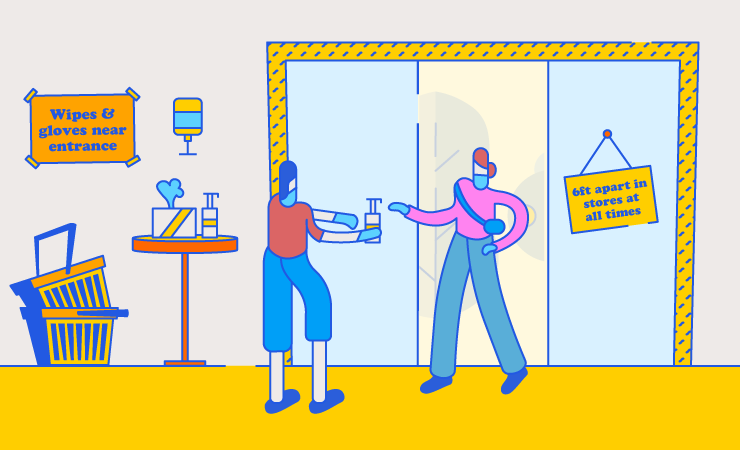‘It’s a lot of extra work’: How the pandemic changed the store associate role

After three years of working at Target, Steve’s shift has been completely transformed this year.
Deemed an essential employee since March, the Tennessee-based employee, who wished to share only his first name, told Modern Retail that the biggest change has been deeper, more frequent cleaning procedures. However, there have also been special training sessions, tech tools and a new re-stocking schedule implemented to keep the store running smoothly.
“I sometimes come in earlier for stock work to limit contact with guests,” he said. And with Target ramping up same-day delivery via Shipt, longtime employees like Steve are also chipping in to fulfill those orders. “Some days, store pickups cause a big backup.”
This need for versatility is being felt across other types of retail workers. Gone are the days when part time employees show up for a run-of-the-mill shift. From fulfilling in-store pickups, to doubling as virtual customer service representatives, retail employees have had to adjust their workflow to keep shopping functional.
Selma, who also asked to be called by her first name, works for a Connecticut consignment shop, had to quickly learn how to list pieces online since the shop launched a Shopify page this summer. “We’ve always sold high-end items, like Coach or Louis Vuitton, on EBay,” she said. But part of the store’s reopening plans include uploading $25-plus listings to Facebook marketplace and its own Shopify page. “We [the staff] take pictures ourselves, upload them and also package and ship everything,” she said.
Staff also dedicates hours to “consignor appointments,” which didn’t exist before the coronavirus, on top of juggling online sales and general customer service. Her typical day consists of repeating chores like cleaning each counter top after every shopper and consignor, cleaning the fitting room after every shopper, spraying hangers with Lysol at the end of the night, spraying the 45 racks of clothing with sanitizing spray along with making sure all tried-on clothes that are quarantined for 72 hours before they’re put on the floor again. It’s a whole new world for a role that once mostly required stocking clothes and interfacing with customers. Due to social distance protocols, on two or three days per week, she’s the lone staffer completing all this at the 2,700 square foot location.
The new semi-virtual retail shift
Retailers this year, especially ones in the apparel and fashion space, are increasingly leaning on workers’ ability to morph into online sales people. One prominent example is Lululemon’s Digital Educator program, which allows customers to book for free, one-on-one 15 or 30-minute appointments with a quarantined associate. Lululemon said the program kept a number of employees from being laid off or furloughed, as well as a high sales conversion rate for Lululemon. But it meant that staff had to go from running fitting rooms and point-of-sale to providing customers service, as well as fit and style tips from their homes.
Another example is women’s apparel brand Chico’s, whose remaining employees helped turn it into an all-digital channel overnight in March. “Luckily, they had the tools and foundation to adapt to this behavior,” said Laura Loughran, senior vp of omnichannel sales at Chico’s.
With new software, Chico’s associates keep in touch and updated customers on stores and e-commerce order changes. The chain has always focused on its white glove personal styling service, called Style Connect, which provides clients with hand-picked items and fitting tips throughout their appointment. “We wanted to extend [our styling offerings] beyond the store’s walls” via channels like SMS and live chat, said Loughran.
That required training store associates to use new tools. Typically, all training is done via curated videos or in-store exercises. Over the last few months, the company used live virtual sessions to get everyone up to speed on how to conduct the Style Connect services. “This allowed us to communicate with the associates at home, and make sure they have resources like product information or customer data,” Loughran explained.
As Chico started to reopen regionally, employees then helped fulfill many tasks. Some locations became fulfillment centers, others turned to appointments-only operating hours and virtual styling sessions. Associates were being encouraged to organize and run virtual events to translate the fitting room experience, which shoppers can attend with their friends.
The key, Loughran said, was to make sure associates feel comfortable in whatever role they’re thrown in. “Someone great operationally can be utilized for pick and packing,” she said. “Those better on the tech side are given responsibilities of online CX.”
A versatile workforce
Over the years, a growing number of people go into stores but end up finishing their purchases online. That leads to an “an obvious disconnect,” in terms of what customers require and in-store associates can offer, said Oscar Sachs, CEO of Salesfloor, a retail tech provider that works with retailers like Saks Fifth Ave. and Bloomingdale’s. In many ways, he said, the pandemic has helped close this gap with the help of virtual in-store tools, like online CX chat, same day pickup or ship-from-store options.
In this new world, store associates are wearing multiple hats. Retailers are also relying on store employees for co-browsing and live streaming duties, noted Sachs. Others are having them pursue conversational commerce tools, such as followup calls or text messaging. For the stores, he said, that means making sure all workers are up to speed. “Retailers have to make sure associates can juggle the omnichannel demands,” he explained.
For Selma, who’s been quickly tasked with managing the store’s health safety and an e-commerce operation, the adaptation is necessary. “It’s a lot of extra work, but it helps keep everyone safe.”
